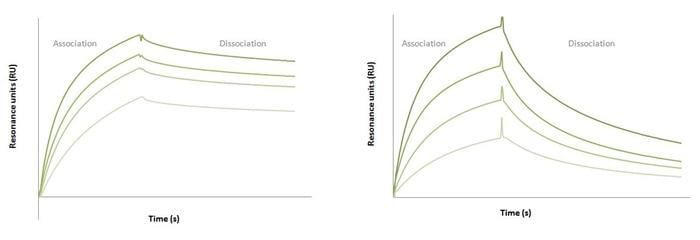For label-free interaction measurements, Creative Biolabs provides surface plasmon resonance (SPR) service based on our Biacore 1K or 8K system. Creative Biolabs has extensive experience in providing SPR services. You can count on us to assist you through your project.
SPR is an optical phenomenon which allows monitoring binding of any two unlabeled molecules in real time. The SPR signal is based on changes in the refractive index at the surface of a gold sensor chip as an analyte flows in a microfluidic channel and binds to a ligand immobilized on the sensor chip. Monitoring the changes in the SPR signal over time results in a plot of the binding response versus time called sensorgram. Fitting of the sensorgram data allows calculation of binding parameters, such as KD, Kon and Koff. On top of the kinetic constants, SPR measurements can be applied for:

Experienced staff at Creative Biolabs will help you through your project, including method development, validation, analysis of delivered samples and transfer to the client upon request. We can provide ready-to-publish or ready-to file data in any format required. Please see below for a list of services we provide.
Label-free interaction studies:
Antibody characterization:
Service dedicated for comparability studies of biosimilars:
Other optional antibody analysis services:
 Fig. 2 LMO2 fusion proteins and the organization of a competitive SPR chip. (Peter Canning, 2021)
Fig. 2 LMO2 fusion proteins and the organization of a competitive SPR chip. (Peter Canning, 2021)
Intracellular antibodies can be used for target verification in preclinical trials and then for compound library screening. LIM Domain Only 2 (LMO2) is a T cell carcinogenic protein that can be activated in most T cell acute leukemia. Here, the researchers used inhibitory intracellular antibody fragments as competitors in the screening of small molecular libraries and identified compounds that bind to LMO2 through competitive surface plasmon resonance experiments. In this study, four compounds that bind to LMO2 were screened but did not bind to anti-LMO2 intracellular antibody fragments. Studies have shown the value of intracellular antibodies in the stages of drug discovery and screening.
SPR is a powerful analytical tool for measuring the binding kinetics and affinity between biomolecules, particularly useful in the study of antibody-antigen interactions. It operates by detecting changes in the refractive index near the sensor surface when binding occurs, allowing researchers to quantify how antibodies interact with their specific antigens in real time without the need for any labels.
SPR offers several advantages including the ability to analyze interactions in real-time, determine the kinetic parameters (association and dissociation rates) of the interaction, and measure the equilibrium dissociation constant (K_D) directly. This label-free technique allows the analysis of the native state of antibodies, providing insights into their functional behavior.
SPR can differentiate between various types of antibody interactions such as high-affinity binding versus low-affinity binding. By providing detailed kinetic data, SPR helps in distinguishing how quickly an antibody binds to and dissociates from its antigen. This is critical in therapeutic antibody screening and development, where different types of interactions can indicate how effective an antibody might be in neutralizing a target.
Sample preparation and conditions are crucial for effective SPR analysis. Typically, the antigen is immobilized on the SPR chip, and the antibody is flowed over the surface. The quality and purity of the antibody sample are important to avoid non-specific binding and to ensure reliable results. Buffer conditions, such as pH and ionic strength, must be optimized to maintain the stability and activity of the antibody during analysis.
SPR is highly sensitive for detecting antibody-antigen interactions. It can measure binding events at concentrations as low as picomolar levels. This sensitivity makes it an invaluable tool for detecting even weak interactions that may be missed by other analytical methods, which is particularly useful in the early stages of antibody development and characterization.
SPR can provide detailed information on the specificity of an antibody towards its antigen. By testing an antibody against multiple antigens or different epitopes of the same antigen under controlled conditions, researchers can determine the level of cross-reactivity and the exact binding specificity. This is crucial for ensuring the selectivity of therapeutic antibodies or diagnostic reagents.
SPR can be adapted to measure antibody interactions within complex matrices, such as serum or cell lysates. By careful preparation and optimization of the experimental conditions, SPR can be used to study how antibodies interact in more physiologically relevant settings, providing insights into their behavior in biological systems.
Use the resources in our library to help you understand your options and make critical decisions for your study.
All listed services and products are For Research Use Only. Do Not use in any diagnostic or therapeutic applications.
| USA:
Europe: Germany: |
|
|
Call us at: USA: UK: Germany: |
|
|
Fax:
|
|
| Email: info@creative-biolabs.com |
